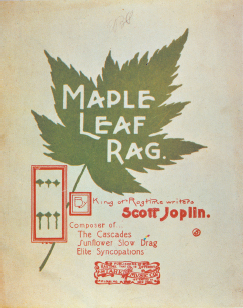The Rise of Pop Music
“Frank Sinatra was categorized in 1943 as ‘the glorification of ignorance and musical illiteracy.’”
DICK CLARK, THE FIRST 25 YEARS OF ROCK & ROLL
Although it is commonly assumed that pop music developed simultaneously with the phonograph and radio, it actually existed prior to these media. In the late nineteenth century, the sale of sheet music for piano and other instruments sprang from a section of Broadway in Manhattan known as Tin Pan Alley, a derisive term used to describe the way that these quickly produced tunes supposedly sounded like cheap pans clanging together. Tin Pan Alley’s tradition of song publishing began in the late 1880s with music like the marches of John Philip Sousa and the ragtime piano pieces of Scott Joplin. It continued through the first half of the twentieth century with the show tunes and vocal ballads of Irving Berlin, George Gershwin, and Cole Porter, and into the 1950s and 1960s with such rock-and-roll writing teams as Jerry Leiber—Mike Stoller and Carole King—Gerry Goffin.

At the turn of the twentieth century, with the newfound ability of song publishers to mass-produce sheet music for a growing middle class, popular songs moved from being a novelty to being a major business enterprise. With the emergence of the phonograph, song publishers also discovered that recorded tunes boosted interest in and sales of sheet music. Songwriting and Tin Pan Alley played a key role in transforming popular music into a mass medium.
As sheet music grew in popularity, jazz developed in New Orleans. An improvisational and mostly instrumental musical form, jazz absorbed and integrated a diverse body of musical styles, including African rhythms, blues, and gospel. Jazz influenced many bandleaders throughout the 1930s and 1940s. Groups led by Louis Armstrong, Count Basie, Tommy Dorsey, Duke Ellington, Benny Goodman, and Glenn Miller were among the most popular of the “swing” jazz bands, whose rhythmic music also dominated radio, recording, and dance halls in their day.
The first pop vocalists of the twentieth century were products of the vaudeville circuit, which radio, movies, and the Depression would bring to an end in the 1930s. In the 1920s, Eddie Cantor, Belle Baker, Sophie Tucker, and Al Jolson were all extremely popular. By the 1930s, Rudy Vallée and Bing Crosby had established themselves as the first “crooners,” or singers of pop standards. Bing Crosby also popularized Irving Berlin’s “White Christmas,” one of the most covered songs in recording history. (A song recorded or performed by another artist is known as cover music.) Meanwhile, the Andrews Sisters’ boogie-woogie style helped them sell more than sixty million records in the late 1930s and 1940s. In one of the first mutually beneficial alliances between sound recording and radio, many early pop vocalists had their own network of regional radio programs, which vastly increased their exposure.
Frank Sinatra arrived in the 1940s, and his romantic ballads foreshadowed the teen love songs of rock and roll’s early years. Nicknamed “The Voice” early in his career, Sinatra, like Crosby, parlayed his music and radio exposure into movie stardom. (Both singers made more than fifty films apiece.) Helped by radio, pop vocalists like Sinatra were among the first vocalists to become popular with a large national teen audience. Their record sales helped stabilize the industry, and in the early 1940s Sinatra’s concerts caused the kind of audience riots that would later characterize rock-and-roll performances.